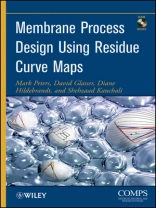Design and Synthesis of Membrane Separation Processes
provides a novel method of design and synthesis for membrane
separation. While the main focus of the book is given to gas
separation and pervaporation membranes, the theory has been
developed in such a way that it is general and valid for any
type of membrane.
The method, which uses a graphical technique, allows one to
calculate and visualize the change in composition of the retentate
(non-permeate) phase. This graphical approach is based on Membrane
Residue Curve Maps. One of the strengths of this approach is that
it is exactly analogous to the method of Residue Curve Maps that
has proved so successful in distillation system synthesis and
design.
provides a novel method of design and synthesis for membrane
separation. While the main focus of the book is given to gas
separation and pervaporation membranes, the theory has been
developed in such a way that it is general and valid for any
type of membrane.
The method, which uses a graphical technique, allows one to
calculate and visualize the change in composition of the retentate
(non-permeate) phase. This graphical approach is based on Membrane
Residue Curve Maps. One of the strengths of this approach is that
it is exactly analogous to the method of Residue Curve Maps that
has proved so successful in distillation system synthesis and
design.
Table of Content
Preface.Acknowledgments.
Notation.
About the Authors.
1 Introduction.
2 Permeation Modeling.
2.1 Diffusion Membranes.
2.2 Membrane Classification.
3 Introduction to Graphical Techniques in Membrane Seperations.
3.1 A Thought experiment.
3.2 Binary Separations.
3.3 Multicomponent Systems.
4 Properties of Membrane Residue Curve Maps.
4.1 Stationary Points.
4.2 Membrane Vector Field.
4.3 Unidistribution Lines.
4.4 The Effect of a-Values on the Topology of M-RCM’s.
4.5 Properties of an Existing Selective M-RCM.
4.6 Conclusion.
5 Application of Membrane Residue Curve Maps to Batchand Continuous Processes.
5.1 Introduction.
5.2 Review of Previous Chapters.
5.3 Batch Membrane Operation.
5.4 Permeation Time.
5.5 Continuous Membrane Operation.
5.6 Conclusion.
6 Column Profiles for Membrane Column Sections.
6.1 Introduction to Membrane Column Development.
6.2 Generalised Column Sections.
6.3 Theory.
6.4 Column Section Profiles: Operating Condition 1.
6.5 Column Section Profiles: Operating Condition 2.
6.6 Column Section Profiles: Operating Condition 3 and4.
6.7 Applications and Conclusion.
7 Novel Graphical Design Methods for Complex Membrane Configurations.
7.1 Introduction.
7.2 Column Sections.
7.3 Complex Membrane Configuration Designs: General.
7.4 Complex Membrane Configuration Designs: Operating Condition1.
7.5 Complex Membrane Configuration Designs: Operating Condition2.
7.6 Complex Membrane Configurations: Comparison with Complex Distillation Systems.
7.7 Hybrid Distillation-Membrane Design.
7.8 Conclusion.
8 Synthesis and Design of Hybrid Distillation-Membrane Processes.
8.1 Introduction.
8.2 Methanol/Butene/MTBE System.
8.3 Synthesis of a Hybrid Configuration.
8.4 Design of a Hybrid Configuration.
8.5 Conclusion.
9 Concluding Remarks.
9.1 Conclusions.
9.2 Recommendations and Future Work.
9.3 Design Considerations.
9.4 Challenges for Membrane Process Engineering.
References.
Appendix A: Mem Wor X User Manual.
A.1 System Requirements.
A.2 Installation.
A.3 Layout of Mem Wor X.
A.4 Appearance of Plots.
A.5 Step-by-Step Guide to Plot Using Mem Wor X.
A.6 Tutorial Solutions.
Appendix B: Flux Model for PERVAP 1137 Membrane.
Appendix C: Proof of Equation for Determining Permeation Timein a Batch Process.
Appendix D: Proof of Equation for Determining Permeation Areain a Continuous Process.
Appendix E: Proof of the Difference Point Equation.
E.1 Proof Using Analogous Method to Distillation.
E.2 Proof Using Mass Transfer.
Index.
About the author
MARK PETERS graduated with both undergraduate and Ph Ddegrees in chemical engineering from the University of the
Witwatersrand in Johannesburg, South Africa. He has previously
worked at Sasol Technology, where he focused on low-temperature
Fischer-Tropsch gas-to-liquids conversion. He is currently a
separations consultant at the Centre of Material and Process
Synthesis (COMPS), based at the University of the Witwatersrand.
DAVID GLASSER is a Personal Professor of Chemical
Engineering and Director of the Centre of Material and Process
Synthesis (COMPS) at the University of the Witwatersrand. He has
been awarded an A1 rating as a scientist by the National Research
Foundation, the central research-funding organization in South
Africa, and has authored or coauthored more than a hundred
scientific papers.
DIANE HILDEBRANDT is the Co-Director for the Centre of
Material and Process Synthesis (COMPS) at the University of the
Witwatersrand. She has authored or coauthored over seventy
scientific papers. She received the Presidents’ Award from the
Foundation for Research and Development as well as the
Distinguished Researcher Award from the University of the
Witwatersrand.
SHEHZAAD KAUCHALI obtained his Ph D at the School of
Chemical and Metallurgical Engineering at the University of the
Witwatersrand. He is currently a full-time senior academic and the
Director of the Gasification Technology and Research Group.
Language English ● Format EPUB ● Pages 248 ● ISBN 9780470922835 ● File size 4.6 MB ● Publisher John Wiley & Sons ● Published 2011 ● Edition 1 ● Downloadable 24 months ● Currency EUR ● ID 2326170 ● Copy protection Adobe DRM
Requires a DRM capable ebook reader












